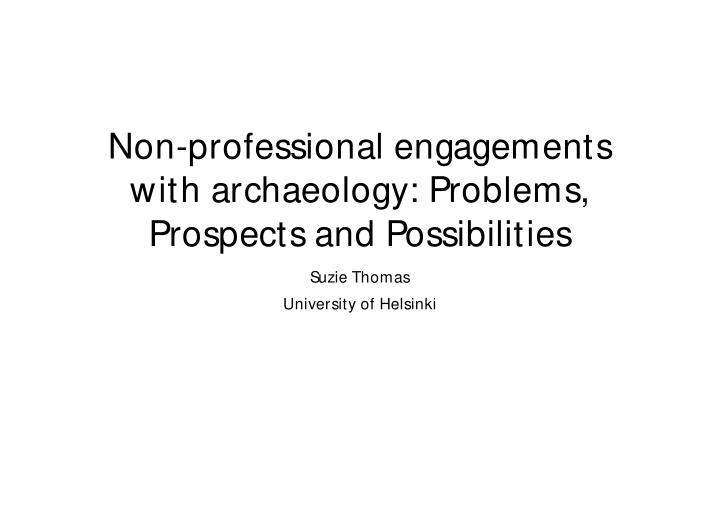



Non-professional engagements with archaeology: Problems, Prospects and Possibilities Suzie Thomas University of Helsinki
Community Archaeology: The Collaborative Continuum ”… collaboration in practice exists on a continuum, from merely communicating research to descendent communities to a genuine synergy where the contributions of community members and scholars create a positive result that could not be achieved without joining efforts. Collaboration, then, is not one uniform idea or practice but a range of strategies that seek to link the archaeological enterprise with different publics by working together.” (Colwell-Chanthaphonh and Ferguson 2007)
Arnstein’s Ladder of Participation (1969)
”searching spectrum” of artefact hunting (Thomas 2016) Looting (criminal intent) -- -- -- -- -- -- -- -- -- -- -- -- -- -- -- -- -- -- -- -- -- -- -- -- -- -- -- -- -- -- -- Hobbyism/Leisure Professional Looting Semi-professional looting Hobbyist artefact hunting Looter Subsistence Digger Opportunist Artefact Hunter Hobbyist Artefact Hunter May include: May include: May include: May include: Individuals who are part of a Individuals who loot Individuals for whom sale of Individuals who are motivated by larger criminal trafficking archaeological sites or steal cultural material is not a hobbyist interests, who do not network from cultural places due to primary motivation but they condone looting or the illicit trade poverty still may trade from time to in cultural objects Theft from cultural places, time Individuals for whom sale of e.g. museums Individuals who regard ‘their’ cultural heritage as an Individuals who do not always cultural material is not a primary Looting of protected sites economic resource to exploit break the law but do on motivation but they still may trade Primary motivation is (e.g. Hollowell 2006) occasion commit crime e.g. from time to time financial gain trespass, unauthorized Individuals who try never to break Possible ‘looting to order’ digging, failure to report the law, and may trade primarily (Hardy 2015) significant finds for hobbyist purposes (e.g. to enhance their collection or to offload ‘duplicates’)
Lapland’ Lapland’s Dark Dark Heritag Heritage: e: Un Under derstanding t standing the C he Cul ultur tural al Legacy of Legacy of Northern Finland’ Northern Finland’s WWII Ger s WWII German man Materialities Materialities wit within Interdisciplina hin Interdisciplinary Perspectives ry Perspectives
Public engagement in Vuotso, Sodankylä, August 2015
The ”continuum of interests” (Koskinen- Koivisto and Thomas, 2016) HISTORY HOBBYISTS Expert-Guides Expert-Explorers Expert-Activists Expert-Collectors
HISTORY HOBBYISTS TREASURE HUNTERS Expert-Guides Expert-Explorers Expert-Activists Expert-Collectors SERIOUS COLLECTORS
Online metal detecting forums
Geo-caching
Public excavation: #InariDig https:// www.youtube.com/ watch?v=SkSdqe_HNXo
• Blog: http:/ / blogs.helsinki.fi/ lapland-dark-heritage/ • Twitter: @DarkLapland • Facebook: Search Lapland’s Dark Heritage • Y ouTube Channel: ”Dark Heritage” • Instagram: @Dig_Inari • Storify: https:/ / storify.com/ DarkLapland
References in slides • Arnstein, Sherry (1969) ”A ladder of citizen participation”, Journal of the American Institute of Planners 35(4), pp.216-224. http:/ / dx.doi.org/ 10.1080/ 01944366908977225 • Colwell-Chanthaphonh, Chip & T . J. Ferguson (2007) ” Introduction: The Collaborative Continuum”, in C. Colwell-Chanthaphonh & T . J. Ferguson (eds) Collaboration in Archaeological Practice: Engaging Descendent Communities , Rowman Altamira. Pp. 1-32. • Hardy, Samuel (2015) ” Is looting-to-order ‘just a myth’? Open-source analysis of theft-to-order of cultural property”, Cogent S ocial S ciences 1(1) http:/ / dx.doi.org/ 10.1080/ 23311886.2015.1087110 • Hollowell, Julie (2006) “ M oral arguments on subsistence digging”, in C. S carre & G. Scarre (eds) The Ethics of Archaeology: Philosophical Perspectives on Archaeological Practice , Cambridge University Press. Pp. 69-93. • Koskinen-Koivisto, Eerika & Suzie Thomas (2016) “ Lapland’s Dark Heritage: Responses to the Legacy of World War II”, in H. Silverman, E. Waterton & S. Watson (eds) Heritage in Action: Making the Past in the Present, Springer. Pp. 121-133. http:/ / doi.org/ 10.1007/ 978-3-319-42870-3_9 • Thomas, Suzie (2016) ” The Future of Studying Hobbyist M etal Detecting in Europe: A Call for a Transnational Approach”, Open Archaeology 2(1), pp. 140-149. http:/ / doi.org/ 10.1515/ opar-2016-0010
Additional sources mentioned in presentation and further reading • Archeowebby (2016) “ Digging our Burrows Cave with Joe Wilson – Episode 57”, podcast available: https:/ / www.archaeologypodcastnetwork.com/ archyfantasies/ 57 • Connerton, Paul. (2008) "Seven types of forgetting“, Memory studies 1(1), pp. 59-71. http:/ / dx.doi.org/ 10.1177/ 1750698007083889 • Herva, Vesa-Pekka, Eerika Koskinen-Koivisto, Oula Seitsonen & Suzie Thomas ”‘I have better stuff at home’: treasure hunting and private collecting of World War II artefacts in Finnish Lapland”, World Archaeology 48(2), pp. 267-281. http:/ / dx.doi.org/ 10.1080/ 00438243.2016.1184586 • Open Archaeology (2016) Topical Issue on Aspects of non-professional metal detecting in Europe, edited by P . Deckers, M. Lewis & S. Thomas. Table of contents available at: http:/ / degruyteropen.com/ tioparasnmde/ • Thomas, Suzie & Eerika Koskinen-Koivisto (2016) ”’Ghosts in the background’ and ’the price of war’: Representations of the Lapland War in Finnish Museums”, Nordisk Museologi 2016(2), pp. 60-77. • Wilson, Joseph (2012) “ The Cave Who Never Was: Outsider Archaeology and Failed Collaboration in the USA”, Public Archaeology 11(2), pp. 73-95. http:/ / dx.doi.org/ 10.1179/ 1465518712Z.0000000007
Recommend
More recommend